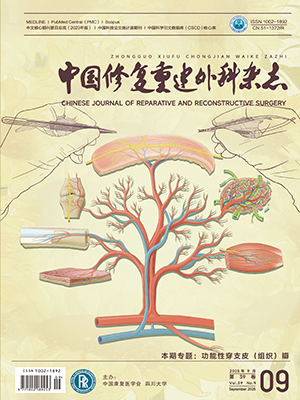| 1. |
Latarjet M. Treatment of recurrent dislocation of the shoulder. Lyon Chir, 1954, 49(8): 994-997.
|
| 2. |
梁达强, 丘志河, 柳海峰, 等. 肩关节前向脱位及合并损伤的手术治疗进展. 中国修复重建外科杂志, 2019, 33(6): 768-773.
|
| 3. |
Longo UG, Loppini M, Rizzello G, et al. Latarjet, Bristow, and Eden-Hybinette procedures for anterior shoulder dislocation: systematic review and quantitative synthesis of the literature. Arthroscopy, 2014, 30(9): 1184-1211.
|
| 4. |
Butt U, Charalambous CP. Complications associated with open coracoid transfer procedures for shoulder instability. J Shoulder Elbow Surg, 2012, 21(8): 1110-1119.
|
| 5. |
Giles JW, Boons HW, Elkinson I, et al. Does the dynamic sling effect of the Latarjet procedure improve shoulder stability? A biomechanical evaluation. J Shoulder Elbow Surg, 2013, 22(6): 821-827.
|
| 6. |
Montgomery SR, Katthagen JC, Mikula JD, et al. Anatomic and biomechanical comparison of the classic and congruent-arc techniques of the latarjet procedure. Am J Sports Med, 2017, 45(6): 1252-1260.
|
| 7. |
An VV, Sivakumar BS, Phan K, et al. A systematic review and meta-analysis of clinical and patient-reported outcomes following two procedures for recurrent traumatic anterior instability of the shoulder: Latarjet procedure vs. Bankart repair. J Shoulder Elbow Surg, 2016, 25(5): 853-863.
|
| 8. |
Yamamoto N, Muraki T, An KN, et al. The stabilizing mechanism of the Latarjet procedure: a cadaveric study. J Bone Joint Surg (Am), 2013, 95(15): 1390-1397.
|
| 9. |
Gendre P, Thélu CE, d’Ollonne T, et al. Coracoid bone block fixation with cortical buttons: An alternative to screw fixation? Orthop Traumatol Surg Res, 2016, 102(8): 983-987.
|
| 10. |
黄刚, 柳海峰, 谢卫勇, 等. 关节镜下改良弹性固定 Latarjet 术治疗一例慢性锁定性肩关节前脱位. 中国修复重建外科杂志, 2019, 33(3): 387-389.
|
| 11. |
Burkhart SS, Debeer JF, Tehrany AM, et al. Quantifying glenoid bone loss arthroscopically in shoulder instability. Arthroscopy, 2002, 18(5): 488-491.
|
| 12. |
Boileau P, Gendre P, Baba M, et al. A guided surgical approach and novel fixation method for arthroscopic Latarjet. J Shoulder Elbow Surg, 2016, 25(1): 78-89.
|
| 13. |
Golish SR, Caldwell PE 3rd, Miller MD, et al. Interference screw versus suture anchor fixation for subpectoral tenodesis of the proximal biceps tendon: a cadaveric study. Arthroscopy, 2008, 24(10): 1103-1108.
|
| 14. |
Griesser MJ, Harris JD, McCoy BW, et al. Complications and re-operations after Bristow-Latarjet shoulder stabilization: a systematic review. J Shoulder Elbow Surg, 2013, 22(2): 286-292.
|
| 15. |
Buchholz A, Martetschläger F, Siebenlist S, et al. Biomechanical comparison of intramedullary cortical button fixation and interference screw technique for subpectoral biceps tenodesis. Arthroscopy, 2013, 29(5): 845-853.
|
| 16. |
Petersen SA, Bernard JA, Langdale ER, et al. Autologous distal clavicle versus autologous coracoid bone grafts for restoration of anterior-inferior glenoid bone loss: a biomechanical comparison. J Shoulder Elbow Surg, 2016, 25(6): 960-966.
|
| 17. |
Barrett Payne W, Kleiner MT, McGarry MH, et al. Biomechanical comparison of the Latarjet procedure with and without a coracoid bone block. Knee Surg Sports Traumatol Arthrosc, 2016, 24(2): 513-520.
|
| 18. |
Weppe F, Magnussen RA, Lustig S, et al. A biomechanical evaluation of bicortical metal screw fixation versus absorbable interference screw fixation after coracoid transfer for anterior shoulder instability. Arthroscopy, 2011, 27(10): 1358-1363.
|
| 19. |
Santos RBMD, Prazeres CMM, Fittipaldi RM, et al. Bankart lesion repair: biomechanical and anatomical analysis of Mason-Allen and simple sutures in a swine model. Rev Bras Ortop, 2018, 53(4): 454-459.
|




